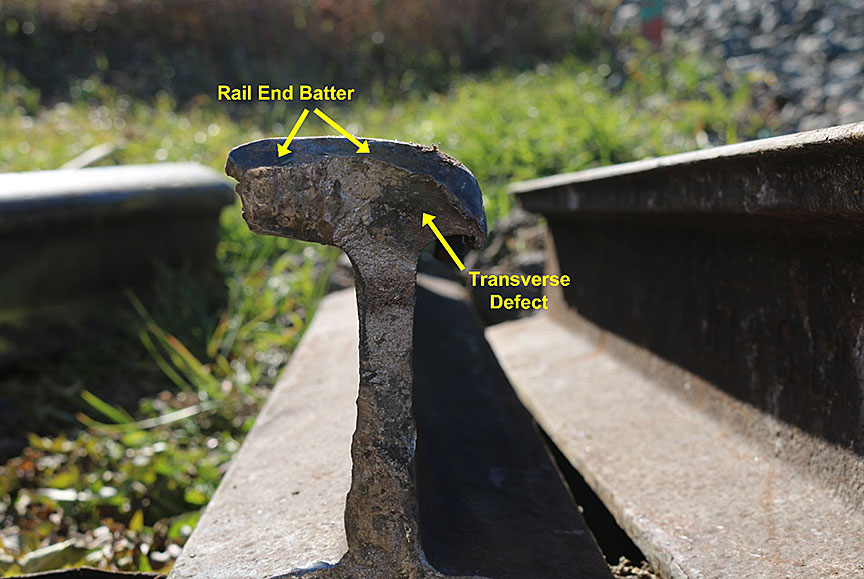Replacement of rail at the end of its service life
Place du Centre
200 Promenade du Portage, 4th Floor
Gatineau QC K1A 1K8
02 November 2017
Safety advisory letter 617-05/17
Related occurrence: R17E0126
Letter addressed to Canadian National Railway Company
Subject: Rail Safety Advisory Letter – 617-12/17: Replacement of rail at the end of its service life
On 22 October 2017, at 13:30 Mountain Daylight Time, CN train A41851-21 (100L, 32E, 13935T, 9139ft) derailed at Mile 8.6 of the CN Westlock Subdivision, just north of the Campbell Park Station, while travelling southward at 21 mph. Post derailment examination revealed that 12 loaded tank cars had derailed, with 4 cars on their side on the right-of-way and 8 cars in accordion position. Two tank cars were confirmed to have been leaking. An estimated 50 to 100 litres of petroleum crude oil (UN1267) had leaked prior to the release being stopped and contained. No injuries were reported (TSB Occurrence No. R17E0126).
Petroleum crude oil (UN1267) is a Class 3 flammable liquid with a wide range of flammability and volatility characteristics. The 06 July 2013 Lac-Mégantic disaster involved a light, low-density, very flammable crude oil. However, the crude oil involved in this derailment was a heavy, tar-like substance that presented a lower risk to public safety.
The point of derailment (POD) was determined to be Mile 8.6 in a 3.5-degree left-hand curve that extended between Mile 8.53 and Mile 8.91.
An examination of rail fragments recovered from the derailment site revealed multiple breaks with some transverse defects (Photo 1).
At the POD, the track is classified as a Class 3 track in accordance with Transport Canada's Rules Respecting Track Safety, and the maximum authorized speed is set to 30 mph. A permanent slow order of 20 mph was in effect between Mile 9.4 and Mile 10.4. In the vicinity of the POD, the low rail had been replaced with 115-pound rail within the last several years. The high rail was 1985 100-pound Sydney continuous welded rail (CWR).
Track geometry testing carried out on 18 September 2017 indicated that, in the vicinity of the POD, the high rail in the curve had a 9 mm vertical wear and a 6.6 mm flange wear, for a maximum combined wear of 15.6 mm, which exceeded its rail wear limits.
The testing also revealed priority wide-gauge defects in the curve. Balanced superelevation in the curve was 2.19 inches and design superelevation was 1 inch, resulting in a 1-inch imbalance. An average superelevation of 1.2 inches was recorded.
In 2017, prior to the occurrence, 7 rail flaw defect (RFD) tests had been conducted. The test closest to the date of the derailment had been performed on 14 September 2017. In the vicinity of the POD, the test had identified detail fracture defects at Mile 8.59 and Mile 8.62, as well as a bolt hole defect at Mile 8.75.
In this occurrence, CN's inspection protocols had identified the condition of the high rail, which had reached condemning limits. However, the identified section of rail had not yet been replaced.
Given the unpredictable growth rates of transverse defects, CN may wish to review the timeliness of the replacement of identified worn and/or fatigued rails on secondary lines where dangerous goods are transported.
Original signed by
Manuel Kotchounian
Acting Director
Investigation Operations, Rail/Pipeline
Background information
Occurrence No.
R17E0126 (Class 5)
Contacts
Dan Holbrook, Manager, Head Office and Western Regional Operations - Rail, Head Office, Gatineau, Quebec
George Fowler, Engineering Specialist/Senior Investigator, Roadbed/Tracks/Signals, Head Office, Gatineau, Quebec
